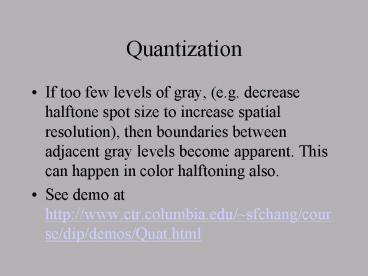Quantization - PowerPoint PPT Presentation
1 / 24
Title:
Quantization
Description:
... levels of gray, (e.g. decrease halftone spot size to increase spatial resolution) ... do not violate color knowledge, e.g. sky is blue, fruit colors, skin ... – PowerPoint PPT presentation
Number of Views:175
Avg rating:3.0/5.0
Title: Quantization
1
Quantization
- If too few levels of gray, (e.g. decrease
halftone spot size to increase spatial
resolution), then boundaries between adjacent
gray levels become apparent. This can happen in
color halftoning also. - See demo at http//www.ctr.columbia.edu/sfchang/c
ourse/dip/demos/Quat.html
2
Saturation
- Distance from white point
- Adding white desaturates but does not change hue
or perceptual brightness. - HSB model is approximate representative of this.
See PhotoShop
3
Device Independence
- Calibration to standard space
- typically CIE XYZ
- Coordinate transforms through standard space
- Gamut mapping
4
Device independence
- Stone et. al. Color Gamut Mapping and the
Printing of Digital Color Images, ACM
Transactions on Graphics, 7(4) October 1998, pp.
249-292. - The following slides refer to their techniques.
5
Device to XYZ
- Sample gamut in device space on 8x8x8 mesh (7x7x7
343 cubes). - Measure (or model) device on mesh.
- Interpolate with trilinear interpolation
- for small mesh and reasonable function
XYZf(device1, device2, device3) this
approximates interpolating to tangent.
6
XYZ to Device
- Invert function XYZf(device1, device2, device3)
- hard to do in general if f is ill behaved
- At least make f monotonic by throwing out
distinct points with same XYZ. - e.g. CMY device
- (continued)
7
XYZ to CMY
- Invert function XYZf(c,m,y)
- Given XYZx,y,z want to find CMYc,m,y such
that f(CMY)XYZ - Consider X(c,m,y), Y(c,m,y), Z(c,m,y)
- A continuous function on a closed region has max
and min on the region boundaries, here the cube
vertices. Also, if a continuous function has
opposite signs on two boundary points, it is zero
somewhere in between.
8
XYZ to CMY
- Given X0, find c,m,y such that f(c,m,y) X0
- if ci,mi,yi cj,mj,yj are vertices on a given
cube, and UX(c,m,y)- X0 has opposite sign on
them, then it is zero in the cube. Similarly Y,
Z. If find such vertices for all of X0,Y0,Z0,
then the found cube contains the desired point.
(and use interpolation). Doing this recursively
will find the desired point if there is one.
9
Gamut Mapping
- Criteria
- preserve gray axis of original image
- maximum luminance contrast
- few colors map outside destination gamut
- hue, saturation shifts minimized
- increase, rather than decrease saturation
- do not violate color knowledge, e.g. sky is blue,
fruit colors, skin colors
10
Gamut Mapping
- Special colors and problems
- Highlights this is a luminance issue so is about
the gray axis - Colors near black locus of these colors in image
gamut must map into something reasonably similar
shape else contrast and saturation is wrong
11
Gamut Mapping
- Special colors and problems
- Highly saturated colors (far from white point)
printers often incapable. - Colors on the image gamut boundary occupying
large parts of the image. Should map inside
target gamut else have to project them all on
target boundary.
12
Gamuts
CRT
Printer
13
Gamut Mapping
- First try map black points and fill destination
gamut.
14
device gamut
image gamut
15
device gamut
translate Bito Bd
image gamut
bs (black shift)
16
device gamut
translate Bito Bd
image gamut
scale by csf
17
device gamut
translate Bito Bd
image gamut
scale by csf
rotate
18
Gamut Mapping
- Xd Bd csf R (Xi - Bi)
- Bi image black, Bd destination black
- R rotation matrix
- csf contrast scaling factor
- Xi image color, Xd destination color
- Problems
- Image colors near black outside of destination
are especially bad loss of detail, hue shifts
due to quantization error, ...
19
Xd Bd csf R (Xi - Bi) bs (Wd - Bd)
shift and scale alongdestination gray
20
Fig 14a, bs0, csf small, image gamut maps
entirelyinto printer gamut, but contrast is low.
Fig 14b, bs0, csf large, more contrast, more
colors inside printer gamut, butalso more
outside.
21
Saturation control
- Umbrella transformation
- Rs Gs Bs monitor whitepoint
- Rn Gn Bn new RGB coordinates such that Rs
Gs Bs Rn Gn Bnand Rn Gn Bn maps
inside destination gamut - First map R RsG GsB Bs to R RnG GnB Bn
- Then map into printer coordinates
- Makes minor hue changes, but relative colors
preserved. Achromatic remain achromatic.
22
Projective Clipping
- After all, some colors remain outside printer
gamut - Project these onto the gamut surface
- Try a perpendicular projection to nearest
triangular face in printer gamut surface. - If none, find a perpendicular projection to the
nearest edge on the surface - If none, use closest vertex
23
Projective Clipping
- This is the closest point on the surface to the
given color - Result is continuous projection if gamut is
convex, but not else. - Bad want nearby image colors to be nearby in
destination gamut.
24
Projective Clipping
- Problems
- Printer gamuts have worst concavities near black
point, giving quantization errors. - Nearest point projection uses Euclidean distance
in XYZ space, but that is not perceptually
uniform. - Try CIELAB? SCIELAB?
- Keep out of gamut distances small at cost of use
of less than full printer gamut use.






























